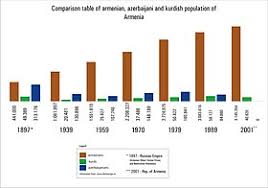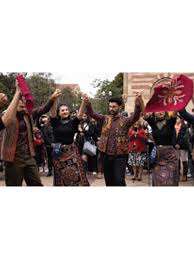Exploring the Cultural Diversity of Armenia: A Tapestry of Traditions

The Rich Tapestry of Cultural Diversity in Armenia
Armenia, a country steeped in history and tradition, boasts a vibrant tapestry of cultural diversity that has been shaped by centuries of influences. From its ancient roots to modern-day practices, Armenia is a melting pot of different ethnicities, languages, religions, and customs.
One of the key factors contributing to Armenia’s cultural diversity is its strategic location at the crossroads of Europe and Asia. Over the centuries, this geographical position has made Armenia a melting pot of various cultures, resulting in a unique blend of traditions that are distinctly Armenian yet influenced by external forces.
Armenia’s cultural diversity is also evident in its population, which includes not only ethnic Armenians but also minority groups such as Yazidis, Russians, Kurds, and Assyrians. Each group brings its own set of traditions, languages, and beliefs to the rich tapestry of Armenian society.
Language is another important aspect of Armenia’s cultural diversity. While Armenian is the official language, minority languages such as Russian, Kurdish, and Assyrian are also spoken in different regions of the country. This linguistic variety reflects the multicultural nature of Armenia and adds to its cultural richness.
Religion plays a significant role in shaping Armenia’s cultural landscape. The majority of Armenians belong to the Armenian Apostolic Church, one of the oldest Christian denominations in the world. However, there are also communities practising other faiths such as Islam and Yazidism. This religious diversity contributes to the mosaic of beliefs and practices that define Armenian culture.
In conclusion, Armenia’s cultural diversity is a testament to its rich heritage and complex history. By embracing the multitude of influences that have shaped its identity, Armenia continues to celebrate its unique blend of traditions while looking towards a future that honours its multicultural past.
Celebrating Armenia’s Cultural Diversity: Enriching Arts, Language, Tolerance, Cuisine, and Heritage
- Armenia’s cultural diversity enriches the country’s artistic expressions, resulting in a vibrant and varied arts scene.
- The presence of multiple languages in Armenia fosters linguistic diversity and encourages cross-cultural communication.
- Different religious practices coexisting in Armenia promote tolerance, understanding, and respect among diverse communities.
- Cultural diversity in Armenia offers a wide range of culinary delights, allowing residents and visitors to experience various flavours and dishes.
- The fusion of traditions from different ethnic groups in Armenia creates a unique cultural tapestry that showcases the country’s rich history.
Challenges of Cultural Diversity in Armenia: Navigating Tensions, Cohesion, Preservation, and Inclusion
- Potential for cultural tensions and conflicts arising from differences in beliefs and practices among diverse ethnic and religious groups.
- Challenges in achieving social cohesion and unity due to varying cultural norms and values within the population.
- Difficulty in preserving traditional Armenian culture amidst the influence of external cultures brought by globalisation.
- Risk of marginalisation or discrimination against minority groups within Armenian society.
Armenia’s cultural diversity enriches the country’s artistic expressions, resulting in a vibrant and varied arts scene.
Armenia’s cultural diversity serves as a powerful catalyst for enriching the country’s artistic expressions. This diverse cultural tapestry, woven from various ethnicities, languages, and traditions, infuses a dynamic energy into Armenia’s arts scene. The fusion of different influences nurtures creativity and innovation, leading to a vibrant array of artistic works that reflect the multifaceted nature of Armenian society. From traditional folk music to contemporary visual arts, Armenia’s cultural diversity acts as a wellspring of inspiration, fostering a rich and varied artistic landscape that captivates audiences both locally and globally.
The presence of multiple languages in Armenia fosters linguistic diversity and encourages cross-cultural communication.
The presence of multiple languages in Armenia fosters linguistic diversity and encourages cross-cultural communication. This rich linguistic tapestry not only reflects the multicultural nature of Armenian society but also serves as a bridge for connecting people from different backgrounds. By embracing and celebrating the various languages spoken within its borders, Armenia creates opportunities for cross-cultural interactions, mutual understanding, and the exchange of ideas, ultimately enriching the cultural fabric of the nation.
Different religious practices coexisting in Armenia promote tolerance, understanding, and respect among diverse communities.
The coexistence of different religious practices in Armenia serves as a powerful catalyst for fostering tolerance, understanding, and respect among diverse communities. By embracing a variety of faiths, Armenians learn to appreciate and accept the beliefs of others, leading to a more harmonious society where mutual understanding and respect thrive. This cultural richness not only strengthens the fabric of Armenian society but also sets an inspiring example of peaceful coexistence for the world to emulate.
Cultural diversity in Armenia offers a wide range of culinary delights, allowing residents and visitors to experience various flavours and dishes.
Cultural diversity in Armenia enriches the culinary landscape of the country, offering a wide array of delightful flavours and dishes for both residents and visitors to savour. From traditional Armenian delicacies like dolma and lavash to influences from minority groups such as Kurdish kebabs and Russian borscht, the diverse culinary scene in Armenia provides a unique gastronomic experience that showcases the richness of its multicultural heritage. Whether exploring bustling markets or dining in local eateries, the fusion of different cooking styles and ingredients reflects the harmonious coexistence of various cultures within Armenia, making it a paradise for food enthusiasts seeking to taste a diverse range of delectable treats.
The fusion of traditions from different ethnic groups in Armenia creates a unique cultural tapestry that showcases the country’s rich history.
The fusion of traditions from different ethnic groups in Armenia creates a unique cultural tapestry that showcases the country’s rich history. By blending customs, beliefs, and practices from diverse ethnic backgrounds, Armenia cultivates a vibrant and dynamic cultural landscape that reflects the interconnectedness of its people throughout centuries. This harmonious integration of traditions not only preserves the heritage of individual communities but also highlights the collective identity of Armenia as a nation enriched by the contributions of various ethnic groups.
Potential for cultural tensions and conflicts arising from differences in beliefs and practices among diverse ethnic and religious groups.
The con of cultural diversity in Armenia lies in the potential for cultural tensions and conflicts that can arise from differences in beliefs and practices among diverse ethnic and religious groups. The coexistence of various communities with distinct traditions and worldviews may lead to misunderstandings, prejudices, and even clashes, posing challenges to social cohesion and harmony within the country. It is essential for Armenia to navigate these differences sensitively and promote dialogue, understanding, and mutual respect among its diverse populations to mitigate the risk of cultural tensions escalating into conflicts that could undermine the country’s unity.
Challenges in achieving social cohesion and unity due to varying cultural norms and values within the population.
One significant challenge posed by cultural diversity in Armenia is the difficulty in achieving social cohesion and unity. The presence of varying cultural norms and values within the population can lead to misunderstandings, conflicts, and divisions among different groups. Differences in traditions, beliefs, and practices may create barriers to effective communication and collaboration, hindering efforts to foster a sense of shared identity and solidarity. Addressing these challenges requires a concerted effort to promote mutual respect, understanding, and acceptance of cultural differences while working towards a common goal of building a more inclusive and harmonious society.
Difficulty in preserving traditional Armenian culture amidst the influence of external cultures brought by globalisation.
In the face of globalisation, one significant con of cultural diversity in Armenia is the challenge of preserving traditional Armenian culture amidst the influx of external influences. As international trends and practices permeate local communities, there is a risk of diluting or overshadowing the distinctive customs, language, and heritage that define Armenian identity. The pressure to adapt to global norms may lead to a gradual erosion of traditional values and practices, posing a threat to the authenticity and continuity of Armenia’s rich cultural legacy. Efforts must be made to strike a balance between embracing diversity and safeguarding the essence of traditional Armenian culture for future generations.
Risk of marginalisation or discrimination against minority groups within Armenian society.
One significant con of cultural diversity in Armenia is the risk of marginalisation or discrimination against minority groups within Armenian society. Despite the country’s rich tapestry of different ethnicities, languages, and religions, there exists a challenge in ensuring that all groups are treated with equality and respect. Minority communities may face barriers to full participation in social, economic, and political spheres, leading to feelings of exclusion and alienation. Addressing issues of marginalisation and discrimination is crucial to fostering a more inclusive and harmonious society where every individual’s cultural identity is valued and celebrated.

